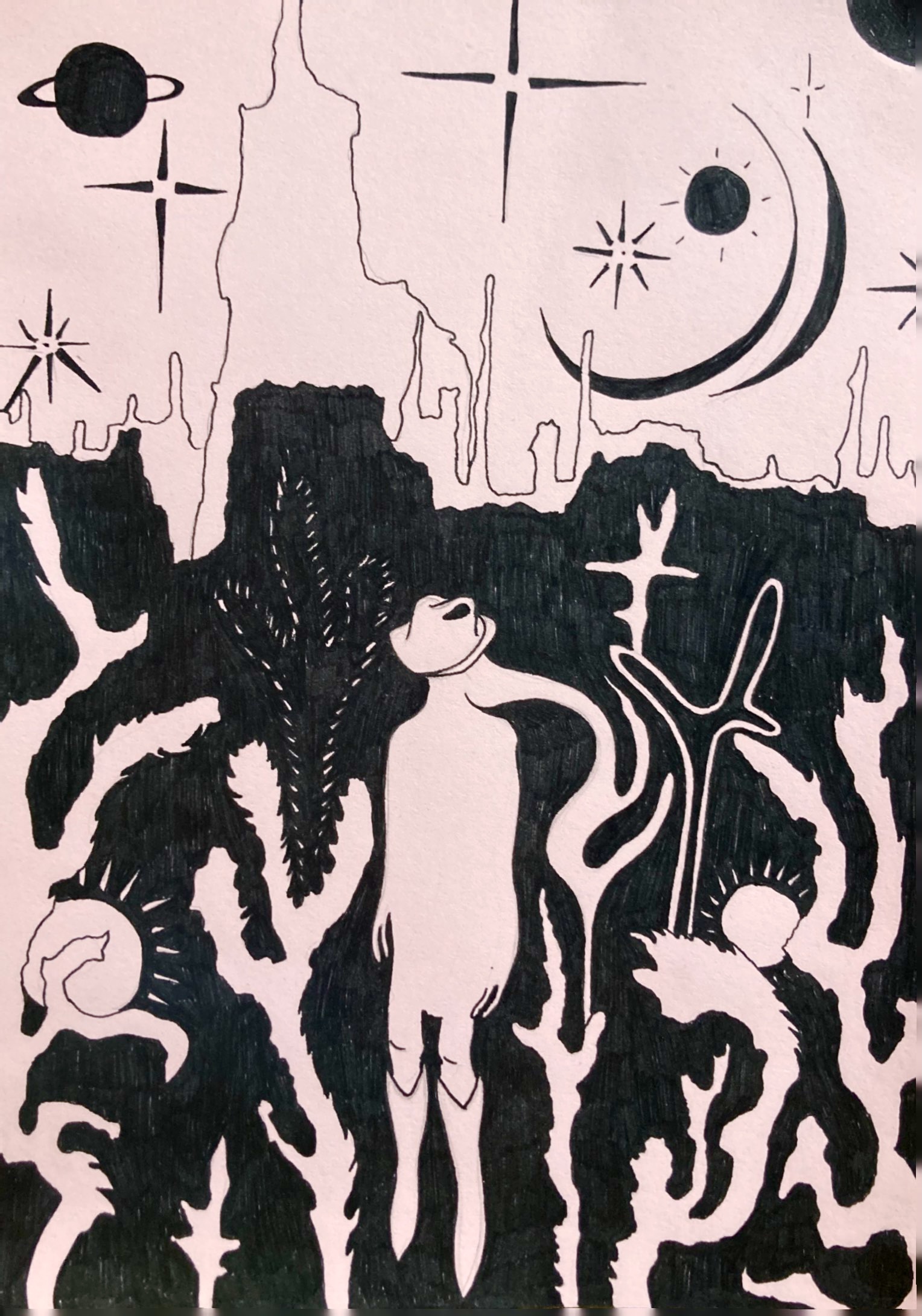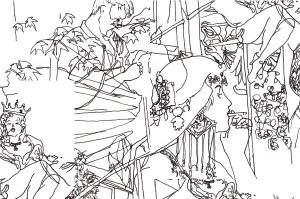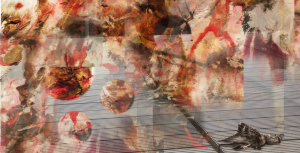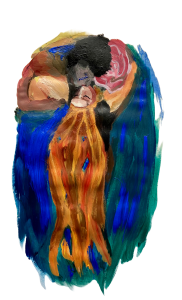
Nostalgia Blues: The Music of Cowboy Bebop
by isised | April 16, 2023
I’m watching tomorrow with one eye
While keeping the other on yesterday.
Shinichirō Watanabe’s Spike Spiegel has one critical affliction: his two eyes do not match. With the vision in one eye he sees the future, whilst the perception of his other eye is glossed over with colours of the past. His former involvement with a crime syndicate keeps coming back to bite him. He’s got a beautiful woman who haunts his waking dreams, too many cigarettes to smoke, a rundown spaceship for a home, and some memories he can’t leave behind.
Throughout the span of 26 episodes, Cowboy Bebop follows its central characters – Spike, Jet, Faye, Ed, and Ein, our motley crew of outlaws – as they run for their lives. They are running from the authorities that chase them, from the relentless allure of the past and the brittle uncertainty of the future. Only towards the end of the show do we realise that the characters are not trying to outrun time, but to chase it. It is a chase for times that are long gone. It is a chase that sees no beginning or end.
1998. Cowboy Bebop teeters on the brink of a new era for music and anime alike. There exists a nostalgia for many old things: the advanced harmonies of mid-40s jazz; the 60s rhythm and blues bleeding into psychedelia; the rock ’n’ roll of the golden 70s; the 80s New Wave. A cocktail of cyberpunk and modern sci-fi masquerading as the pastiche for noir and spaghetti Westerns, Bebop prompts us to recall a myriad of genres and ideas. It is an adventurous space-opera woven with ballads and folklores, a neo-noir tragicomedy that blends pulp fiction with existential solipsism. Its landscape brings miscellaneous cultures into collision, infecting the settlement of a Chinese diaspora with the seedy neon aesthetics of the Wild West, which results in a gorgeously sordid hybrid of Hong Kong, Morocco, and New York City. It has the razor-edged sharpness of Blade Runner, the scathing wit of Scarface, the ludicrous humour of Lock, Stock, and Two Smoking Barrels, the doomed allure of Waterloo Bridge, and yet the ruminative melancholy of Casablanca. Like Spike, the creation of Cowboy Bebop looks ahead with one eye yet turns to the past with the other. The off-kilter mixture of anticipation and nostalgia unsettles Watanabe’s work and redefines a new genre entirely.
Nostalgia: an affliction defined by sentimentality; a desire to return to a time past or to restore a set of irrevocable circumstances, a pleasurable sorrow.
Just as Spike chases a past that no longer exists, Watanabe looks for a genre that is slowly dying before the approach of the 21st century. A strange, tremulous fear lingers over the work’s shoulder. Is this the end of cinema as we know it? Is this the end of anime as we know it?
Bebop – the name of Spike Spiegel and Jet Black’s spaceship – is a throwback to a style of jazz that defies musical formula and seeks above all else to tear apart the seams of restraint. It is tinkling keys on an unstoppable tempo; it is spontaneity, improvisation, discordant harmony. The episodes are jam sessions. Not only does the title immediately evoke a haunting musical era – Charlie Parker’s whooping alto sax, Thelonious Monk’s piano keys, Dizzy Gillespie’s trumpet or Buddy DeFranco’s clarinet – but through music, Watanabe ensures that Bebop’s futuristic setting feels like home. This isn’t Harlem of the late 1940s, but his devotion is clear: samples of popular culture are ubiquitous.
Tracks by Aerosmith, Queen, and KISS are name-dropped as jam session titles. Jet’s nickname (Black Dog) is only the first Led Zeppelin allusion. Spike’s lost lover, Julia, takes her name from The Beatles track, whilst Faye Valentine is named after one of Richard Rodger’s most celebrated jazz standards. The backing track on the session ‘Pierrot Le Fou’ is a homage to Pink Floyd’s ‘On the Run’. You gotta carry that weight, he says, as if the unspoken nostalgia hadn’t already gnawed our hearts raw.
Abrasive metal riffs thrum along with the blood in our veins. Jamming (musically) with Edward becomes jamming (computer signals from a satellite) with our favourite hacker, Radical Edward. The term “monkey business” is a blatant Chuck Berry reference. The recurrent trio of bickering, drunk passers-by at the bar are named Antonio, Carlos, and Jobim, after the Brazilian composer Antônio Carlos Jobim, a bossa nova pioneer. The familiarity of Mick Jagger’s and Keith Richards’s lyrics makes us smile: this is a world, after all, full of honky-tonk women and wild horses with some sympathy for the Devil to spare. Who wouldn’t want to go back to when Muddy Waters begged you not to go down to New Orleans, when John Lee Hooker lamented that it served him right to suffer, when Howlin’ Wolf was still moanin’ in the moonlight? Who wouldn’t want to go back to the days when they had the key to the highway?
Shinichirō Watanabe’s Faye Valentine faces one fatal obstacle: she has no memory of who she used to be. With 54 years torn from her grasp by an aircraft accident, Faye is a girl out of her time. She is tethered only by fragmented recollections, images of statues and infrastructure. When the memory of where she used to belong finally returns, the sun has sunk below the horizon and she finds the long-awaited home in ruins, gnawed into rubble by ruthless age. Fate is cruel to Faye. Though she finally remembers her past, she is eternally separated from it.
Bebop mocks tropes of the spaghetti western and pays homage to the noir, haunting us with familiar shadows of femme fatales and snarky men filled with hollow witticisms. Spike’s entire character design pays a far too obvious homage to Lupin III. This form of self-recognition through popular culture sees its climax when an entire subplot is lifted out of Shaft (1971) as the characters experiment with psychedelia. In a cloud of mushroom-induced hallucinations, the longings and reveries of each of the characters are revealed. Jet finds a moment of tranquillity with his beloved Bonsai trees; Faye is cast adrift at the bottom of the ocean, helpless, amidst a swarm of fish whose memories are as transient as her own, whilst Spike faces a looming stairway, an endless climb leading him towards damnation or redemption.
Bebop is a conversation between all its creative counterparts: the visuals bouncing off the music, a relentless, eclectic engagement of graphics, story, and momentum. The vivacity of its scenery – its vibrant colours, garish, almost kaleidoscopic – is never without an aftertaste of existential ennui as the music softens to halt: a loneliness, a kind of bitter melancholy made sweet.
This is nostalgia made tangible and comprehensible by the anime’s disjointed narrative. This is a call-back to a long-lost cultural era that now seems to us as stranger than fiction.
This is the future that terrifies us beyond all things.
For all that yearning for the past, Bebop tells a story of the future. This is a world where bounty hunters walk alongside punk angels, where diverse cultures blend together as humanity disperses into the galaxy, where spaceships are vehicles and super-computers can hypnotize human minds. The irony is palpable. Even when we look towards the future –towards a world where technologies map our coordinates and our identities, where human-colonised planets are within arm’s reach – we still find comfort in the familiar refrains, the samba, the heavy metal, the jazz, the old melodies of our pleasurable sorrows. We see our own nostalgia reflected back at us. Even in a world so futuristic that it is barely recognisable, the ghost of pop culture makes it ours. If we must see past and future both through a single pair of eyes, Watanabe asks, could we really distinguish between the two?
Each session details a story of its own, breaking conventions of linear narrative altogether: the timeline flits back and forth between Spike’s turbulent and bloodthirsty youth, Jet’s former career, Faye’s elusive past, clashing diverse temporalities with one another. Never before has anime witnessed such a radical shattering of narrative linearity. This is a genre where free, boundless temporalities can co-exist at once, layered, multiplex and dazzling, where ruins bear memory and the immense unknown of the future looms as a perpetual shadow.
It takes courage to look into a space of immense uncertainty – which the future, invariably, always is. This is the future that Watanabe wishes to address. A soundless, unspoken void where all that we love could disintegrate.
Bebop, with its cult following, has become a so-called icon. In the word ‘icon’ we find Christian connotations of veneration and religious sanctity that are uniquely fitting in this cultural context. We worship the idols of popular culture in music, cinema, animation, and art alike: it has become its own religion. The age-gone past is always an age romanticised. We long to go where we cannot go. We are never satisfied with our present. The past is always grander, better, more intimate, a space of lyric and inspiration fuelled by the curse of our imagination.
Shinichirō Watanabe’s Radical Edward has a smile bigger than anything, bigger than the emptiness at the bottom of our glass. She’s got a headful of code and the entire universe at her feet, with a wise, lonesome dog for company. Ed isn’t sure of where she wants to be; she doesn’t know if she’s chasing a father she never met or a dream she never had. Ed is perhaps the cleverest of us all. When she left the only place she ever called home behind, she didn’t even say goodbye.
In saluting the finale of a century, Watanabe knows that no goodbye is necessary.
We venerate how the late 20th century has identified contemporary popular culture. Nostalgia makes disciples of us all. Why else did the Coen brothers make The Big Lebowski if not to retrieve the trope of the private detective? Why else did David Fincher make Mank if not to dramatise the making of a 1941 classic that is already inherently associated with drama? Why did Lynch make Mulholland Dr. if not to find another Sunset Boulevard, why did Polanski make Chinatown if not to bring noir to its subsequent climax, and why else did Tarantino make Once Upon A Time in Hollywood if not to reminisce an epoch that we worship beyond all things? We perpetually herald the era that no longer is, frantically scramble to preserve its final traces, to turn it over, to press its dead leaves into our unwritten pages. We are caught up in the dying culture’s blazing taillights, always chasing after the glory of our predecessors like chasing the sunset at dusk, like chasing waves into the shallows of our ocean. We try to make sense of the golden age of something we loved so much that we could never fully restore it. If we do it again, we might get something new out of it. Cowboy Bebop falls into the same category. By the time we finish that drink at the end of the night, maybe the piano will play a tune that we’ve never heard before. And then, maybe, it’ll be the beginning of a new genre altogether.
Do it again. Rewind. Send the record player spinning.
Shall we dance? To a new genre of music, this time? Don’t worry if you step on my feet. We’ll learn together.
As Spike raises a toast to the bridges he burned, we find harmonies of a new music. In Jet’s morose affection, Faye’s languid, smoke-rattled laughter, and the tap, tap, tapping of Ed’s fingers across a keyboard, in the silence after a gunshot and the trail of a blazing spaceship across the sky: that alone is its own kind of music. Watanabe knows that in order to look back, we must also look forwards. We are all watching tomorrow with one eye whilst keeping the other on yesterday. We hold our breaths in anticipation of what’s to come even when we cannot bear to let go.
As the concept of popular culture churns and shifts, withers and blooms, disintegrates and transforms, new shapes, new asteroids, new phenomena will overtake us. This is the speed of light our acceleration cannot reach.
And perhaps, if there is enchantment – in a laugh, a tune, a memory, a life – we will find it again. And again. Sometime in the future, what we have lost will return over and over in unrecognisable, breathtaking forms. So instead of saying farewell, we should only wave our hand and repeat what Shinichirō Watanabe had whispered in our ear, shouldn’t we? This is not goodbye. This is only—
See you, space cowgirl.
Someday, somewhere.∎
Words by Cici Zhang. Art by Cleo Scott.




